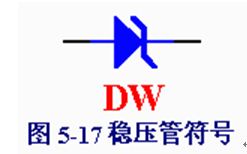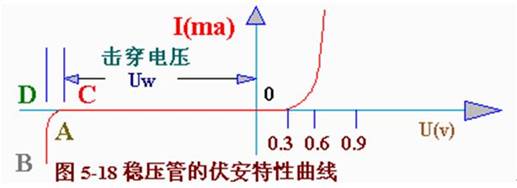Principle and Application of Zener Diode
Time:2022-10-18
Views:1680
To understand the operating principle of the zener diode, you only need to understand the reverse characteristics of the diode. The basic characteristic of all crystal diodes is unidirectional conduction. That is to say, the forward pressurization is on, and the reverse pressurization is not. There is a condition that the reverse pressurization shall not exceed the reverse withstand voltage value of the pipe. What is the result after exceeding the withstand voltage value? A simple answer is that the pipe is burnt. But that‘s not the whole answer. The test found that, as long as the reverse current value is limited (for example, a resistance is connected in series between the tube and the power supply), the tube will not burn down even though it is broken down. It is also found that after the reverse breakdown of the tube, the current changes from large to small, and the voltage only drops slightly, until it drops to a certain current value, then the voltage drops sharply with the decrease of the current. It is precisely by taking advantage of this feature that people have created a zener diode. The key to using zener diode is to design its current value.



The characteristic of zener diode is that after breakdown, the voltage at both ends of the diode remains basically unchanged. In this way, when the voltage regulator tube is connected to the circuit, if the voltage of each point in the circuit changes due to power supply voltage fluctuation or other reasons, the voltage at both ends of the load will basically remain unchanged.
Operating principle of zener diode and application circuit of zener diode
1、 Principle and characteristics of zener diode
Generally, the triode is conducted in the forward direction and cut off in the reverse direction; If the reverse voltage applied to the diode exceeds the withstand capacity of the diode, the diode will be broken down. But there is a diode whose forward characteristic is the same as that of ordinary diodes, while its reverse characteristic is special: when the reverse voltage is applied to a certain extent, although the tube is in a breakdown state, it will not be damaged through a large current, and the repeatability of this phenomenon is very good; On the contrary, as long as the pipe is in the breakdown state, although the electricity flowing through the pipe is changing greatly, the voltage at both ends of the pipe changes very little to stabilize the voltage. This special diode is called voltage regulator.

Models of voltage stabilizing tubes include 2CW, 2DW, etc. Its circuit symbols are shown in Figure 5-17.
The voltage stabilizing characteristic of the voltage stabilizing tube can be clearly shown by the volt ampere characteristic curve shown in Figure 5-18.

The voltage stabilizing tube works by using the voltage stabilizing characteristic of multi zone reverse striking. Therefore, the voltage stabilizing tube should be connected in reverse in the circuit. The reverse breakdown voltage of the voltage stabilizing tube is called the stable voltage. The stable voltage of different types of voltage stabilizing tubes is also different. The voltage stabilizing value of a certain type of voltage stabilizing tube is fixed within the specified range. For example, the voltage stabilizing value of 2CW11 is 3.2V to 4.5V. The voltage stabilizing value of one pipe may be 3.5V, and that of the other pipe may be 4,2V.
In practical application, if you cannot select a voltage stabilizing tube with a voltage stabilizing value that meets the needs, you can select a voltage stabilizing tube with a lower voltage stabilizing value, and then connect one office or several silicon diodes in series to "pillow pads" to increase the stable voltage to the required value. This is achieved by using the silicon diode‘s forward voltage drop of 0.6~0.7 V. Therefore, the diode must be positively connected in the circuit, which is different from the regulator.
The voltage stabilizing performance of voltage stabilizing tube can be expressed by its dynamic resistance r:

Obviously, for the same current variation Δ 1. Voltage change at both ends of voltage stabilizing tube Δ The smaller the U, the smaller the dynamic resistance, and the better the performance of the voltage regulator tube.
The dynamic resistance of the voltage stabilizing tube changes with the working current, and the greater the working current is. The smaller the dynamic resistance. Therefore, in order to achieve good voltage stabilization effect, the working current should be selected properly. If the operating current is larger, the dynamic resistance can be reduced, but it cannot exceed the allowable current (or dissipated power) of the tube. The operating current and allowable current of various types of tubes can be found in the manual.
The stability of the voltage stabilizing tube is affected by the temperature. When the temperature changes, its stable voltage will also change. The temperature coefficient of the stable voltage is commonly used to express this performance. For example, the stable voltage of the 2CW19 voltage stabilizing tube Uw=12 volts, and the temperature coefficient is 0.095% ℃, indicating that the stable voltage will increase 11.4 millivolts for every 1 ℃ increase in temperature. In order to improve the stability of the circuit, appropriate temperature compensation measures are often used. When the stability performance is required to be very high, it is necessary to use voltage stabilization with temperature compensation, such as 2DW7A, 2DW7W, 2DW7C, etc.
II Voltage stabilizing circuit diagram of voltage stabilizing diode
A simple voltage stabilizing circuit composed of silicon voltage stabilizing tubes is shown in Figure 5 - l9 (a). The silicon voltage stabilizing tube DW is connected in parallel with the load Rfz, and R1 is the current limiting resistor.
How does this circuit stabilize voltage?
If the grid voltage rises, the output voltage Usr of the rectifier circuit also rises, causing the load voltage Usc to rise. Since the voltage stabilizing tube DW is connected in parallel with the load Rfz, the current flowing through the voltage stabilizing tube will increase sharply as long as there is a small increase in Usc, making I1 also increase, and the voltage drop on the current limiting resistor R1 increase, thus offsetting the increase in Usr and keeping the load voltage Usc basically unchanged. On the contrary, if the grid voltage decreases, causing a decrease in Usr and Usc, then the current in the voltage stabilizer decreases sharply, causing I1 to decrease, and the voltage drop on R1 to decrease, thus offsetting the decrease in Usr and keeping the load voltage Usc basically unchanged.
If Usr remains unchanged but the load current increases, the voltage drop on R1 increases, causing the load voltage Usc to decrease. As long as Usc decreases a little, the current in the voltage stabilizing tube decreases rapidly, so that the voltage drop on R1 decreases again, thus keeping the voltage drop on R1 basically unchanged, so that the load voltage Usc can be stabilized.
To sum up, it can be seen that the voltage stabilizing tube plays the role of automatic current regulation, while the current limiting resistor plays the role of voltage regulation. The smaller the dynamic resistance of the voltage regulator, the greater the current limiting resistance, and the better the stability of the output voltage.
|
Disclaimer: This article is transferred from other platforms and does not represent the views and positions of this site. If there is any infringement or objection, please contact us to delete it. thank you! |











